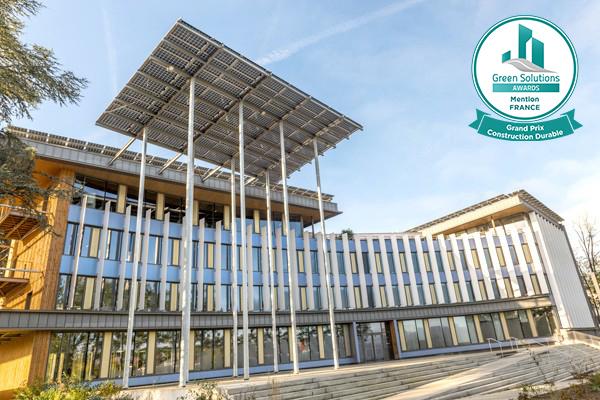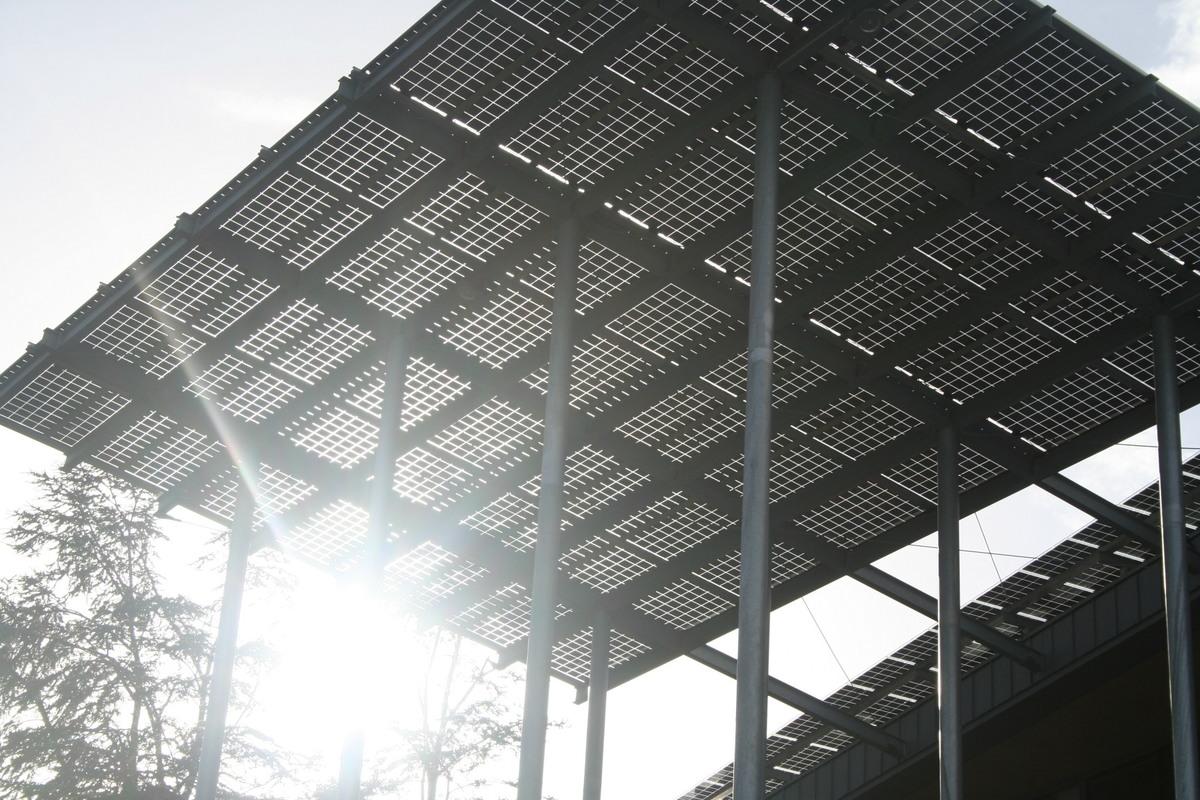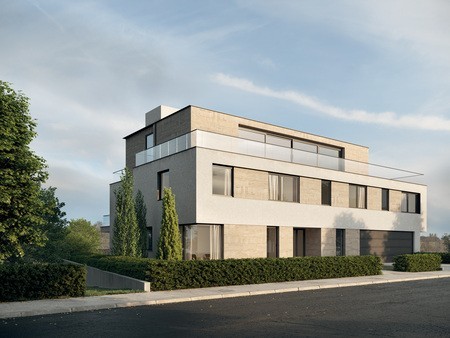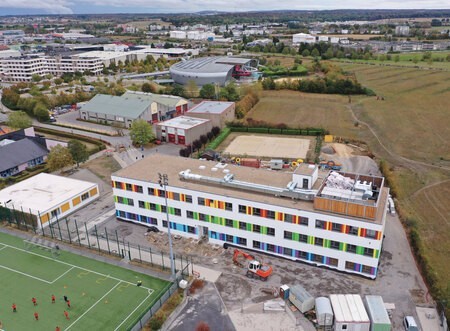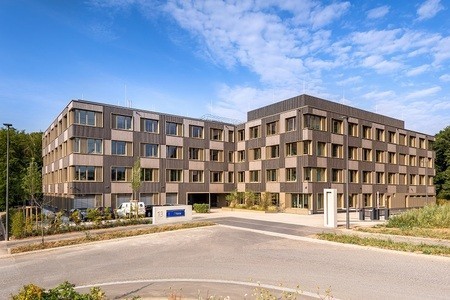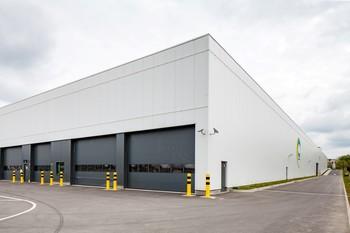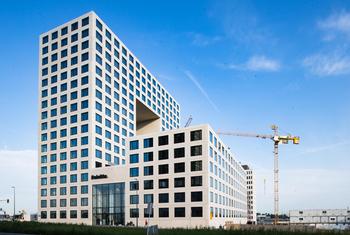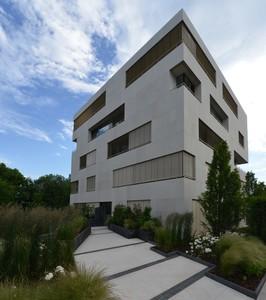Delta Green
Last modified by the author on 25/09/2018 - 12:11
New Construction
- Building Type : Office building < 28m
- Construction Year : 2016
- Delivery year : 2017
- Address 1 - street : 44800 SAINT HERBLAIN, France
- Climate zone : [Cfb] Marine Mild Winter, warm summer, no dry season.
- Net Floor Area : 4 608 m2
- Construction/refurbishment cost : 6 570 000 €
- Number of Work station : 380 Work station
- Cost/m2 : 1425.78 €/m2
Certifications :
-
Primary energy need
100 kWhep/m2.an
(Calculation method : )
On delivery, the only building in France that produces, stores and recovers electrical energy via a hydrogen station.
Delta Green is a building that meets the Passiv Haus certification requirements for high energy performance of the building.
This labeling process is not the least restrictive but in our opinion the most relevant and the most consistent with the requirements of this project.
He was also awarded in 2017 at the Silver Pyramids of the REIT (Federation of Real Estate Developers) at the regional level and ranked among the 3 best projects at the national level: Pyramids of gold.
A postulate "ALL USES" The whole of all the consumptions is taken into account.
A reasoning: GLOBAL COST at the market price by integrating investment AND operation - maintenance (all rental charges AND own consumption).
One objective: AUTONOMY To be autonomous in annual smoothing:
To produce globally more than all the consumptions over one year.
Sustainable development approach of the project owner
Today, we design buildings that are theoretically more and more efficient, but in reality energy consumption
realities are not mastered. The desire is to create an office building that is energetically positive, every day, and tends towards self-sufficiency. (with smoothing of annual energy consumption)
ONE OBJECTIVE: 4 CHALLENGES TO BE TAKEN
- TO AVOID :
Minimize energy consumption by designing a building with low energy requirements. For this, the south and north orientations, the diffusion of natural light and the innovative materials were favored.
- PRODUCE:
Achieve a higher energy output than that consumed by the building using photovoltaic panels, a wood boiler and a passive cooling system.
- STORE:
Store the energy produced to cope with building consumption during periods of energy deficit.
- USE :
To sensitize the occupants in an awareness of their energy impact by presenting them in a pedagogical way the consumptions and the productions of energy in order to make them actors of the good use of their place of work.
Architectural description
The Deltagreen project places these fundamentals at the center of its design:
1. NATURAL LIGHT
- Variable geometry for optimization of natural light: distance between frontage of 12m without central core at 20m with central core.
- Cutting of the constructive influence to favor the North and South orientations for the glazed parts and East and West for the solid parts in order to optimize the solar protections
- Faced with the first energy consumption that is artificial lighting, the workspaces have been sized according to the ideal penetration of natural light.
2. FLEXIBILITY OF SPACES
Structure "neither wall nor post":
- No rests or beams in fallout (No reservations)
- No lintels in front (High entrance of the light)
- Supports façade panels (no facade structure)
- Free trays
- "Structure" and "Skin" differentiated and separated (plane of the brakes-steam)
- Economic: Mutualization of floor structures and joinery
- Architectural freedom of writing (horizontal or vertical overlap on the facade)
The goal is to give users freedom. They must be able to arrange the space without constraints. We manufacture the fixed parts of buildings in which the user will not bump.
3. PERFORMANCE OF THE ENVELOPE
- Timber frame fixed on structure "neither wall nor post"
- Airtightness
- Vacuum insulator on full part of openings
- Management of thermal bridges
Building users opinion
"This relocation project reflects our ambitions for further development of FIDAL in the region. Our installation in these new premises, modern, spacious, functional in a very innovative building will allow us to welcome our customers in optimal conditions and to provide an even more fulfilling working environment to our teams. In addition, we are pleased to integrate this positive energy building, which is fully in line with the firm's environmental policy. "
Eric Joanne, Regional Director of FIDAL, operator of the building on 2 levels.
If you had to do it again?
We would do everything in the same way but had imagined fewer administrative and legal constraints. The initial ambition was "Can we imagine unplugging the building network: 100% autonomy" In the end a self-contained building smoothed over the year the only obstacle to ambition: the costs would have imposed a balance of storage and production of hydrogen for several million euros. Incompatible with the economy of the project ... The future may allow it ...
See more details about this project
http://galeo.fr/programmes/deltagreen/https://www.construction21.org/france/data/sources/users/10929/divisibilite-du-batiment.docx
Contractor
Construction Manager
Stakeholders
Thermal consultancy agency
ITF
Bruno GEORGES - 04 79 75 00 29- [email protected]
https://www.itf.biz/fr/ENGINEERING ENERGY DESIGN - THERMAL -
Structures calculist
SERBA
Yoann GUITTENY- 02 51 11 10 99 - [email protected]
http://www.serba.net/DESIGN - ENGINEERING STRUCTURE AND ECONOMY
Construction Manager
ESSOR
Caroline DEHAUT - 02 51 80 66 20 - [email protected]
https://www.essor.groupENGINEERING OF REALIZATION
Facility manager
SOLARIS GESTION
Karl BRICHETEAU - 02 85 52 49 00 - [email protected]
https://www.solaris-gestion.frMANAGER - PILOT OF THE ENSEMBLE
INSITECH
Vincent VILLENEUVE - [email protected] - 09 52 90 30 70
https://www.insitek.frCompany
POWIDIAN
Bertrand CHAPUIS - [email protected] - 06 70 16 60 05
http://powidian.comHYDROGEN STATION
Contracting method
Separate batches
Type of market
Table 'c21_luxembourg.rex_market_type' doesn't exist
Energy consumption
- 100,00 kWhep/m2.an
- 110,00 kWhep/m2.an
Real final energy consumption
44,01 kWhef/m2.an
27,34 kWhef/m2.an
2 017
Envelope performance
- 0,52 W.m-2.K-1
- 0,32
- 0,33
Systems
- Geothermal heat pump
- Others
- Electric floor heating
- Solar thermal
- Individual electric boiler
- Geothermal heat pump
- Floor cooling
- Others
- Double flow heat exchanger
- Solar photovoltaic
- Heat Pump on geothermal probes
- Other, specify
- 51,27 %
Smart Building
Urban environment
- 4 825,00 m2
- 2 268,00 %
- 1 912,00
Product
PHOTOVOLTAIC PRODUCTION
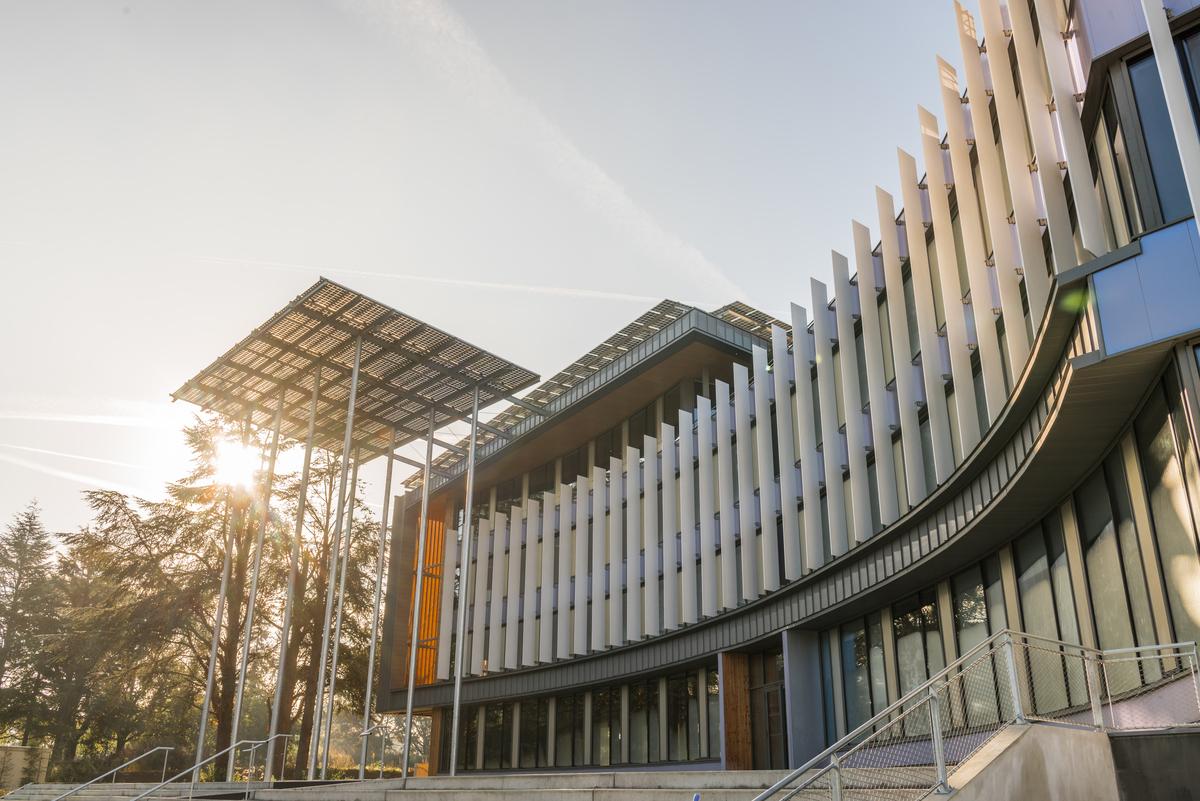
AR MOR GREEN
Nicolas ROLLAND
http://www.armorgreen.fr
Photovoltaic production: part of the production is used for self-consumption, the rest is reinjected into the network. The entire periphery of the roof of the building is equipped with panels. A roof was also intentionally created and covered with photovoltaic panels.
YES
Hydrogen station
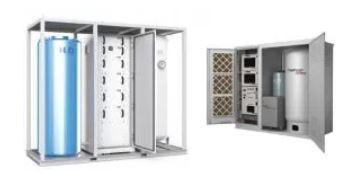
POWIDIAN
Bertrand Chapuis - [email protected] - 06 70 16 60 05
https://www.powidian.com
Hydrogen station: under certain conditions; the surplus of photovoltaic production intended for self-consumption is injected into a hydrogen station: by electrolysis of hydrogen is then produced and stored. In low sunlight conditions (mainly winter), hydrogen is then used as a fuel in a hydrogen cell to reinject electricity into the building.
YES
Construction and exploitation costs
- 1 100,00 €
- 300 000,00 €
- 50 000 €
- 6 570 000 €
- 23 000 €
Energy bill
- 21 400,00 €
Water management
- 427,00 m3
Indoor Air quality
Comfort
- the optimizations of orientations of the facades, the maximum north and south
- cutting the building, varying the thickness of the trays from 12.2 to 14 meters maximum
- the height of 3.3 m between slabs to penetrate the light to the furthest
- the absence of lintel on the facade thanks to the system neither wall nor posts
GHG emissions
- 3,00 KgCO2/m2/an
- 25,00 année(s)
- 946,00 KgCO2 /m2
Reasons for participating in the competition(s)
STRONG POINTS From the energy point of view
- 3 photovoltaic fields:
-In roofs for resale.
-In acroterium for self-consumption and storage
-In the shade for resale.
- A shadows propels a photovoltaic field to a height of 16 meters, a real signal of the program's environmental and energy ambitions. Thermal comfort:
-Heating and cooling is provided by a complex of active slabs and a PAC system on vertical probes in geocooling.This mode of emission ensures a very high comfort for the occupants (no draft, exchange by radiation) .
- Annual global energy balance Annual photovoltaic production is estimated at 520 MWh of primary energy when the annual consumption of the building (all uses) reaches 476 MWh of primary energy.
- Smooth on the year, the building is autonomous in energy and even surplus.
HIGHLIGHTS From an environmental point of view
- To optimize natural resources, the North and South orientations were favored with largely glazed facades and protected from direct sunlight by 4 different solar shading devices depending on the exposure.
- To preserve nature, existing trees and the "undergrowth" aspect of the environment have been preserved. All materials used for facades are part of a logic of sustainability and simplified maintenance.
- In the long term, all these materials are recyclable. Technological advances could encourage these facades to evolve easily by inter-changing the panels without structural intervention.
- Total adaptability thanks to the concept "Neither beam nor post" That is 92% of free spaces of structure and having access to the natural light (92% of the surface with FLJ> 2.5%)
From a digital point of view (BIM, etc.):
- A 10-month fine job to highlight this unique concept by modeling the whole building under a BIM model.
From the point of view of uses, practices:
- A system of centralized technical management of the building (GTC) ensures the control of the building, the management of the equipments, the measurements and controls of the data which allow the follow-up of the site in an optimal way to reach and optimize the expected performance in a logic of permanent improvement.
-A "Welcome Home" user's guide, intended for all users.
-A home screen that informs users and visitors in real time about the energy data of the building accessible remotely
Building candidate in the category

Energie & Climats Tempérés

Coup de Cœur des Internautes

Grand Prix Construction Durable





